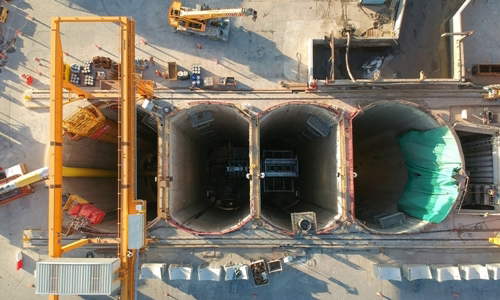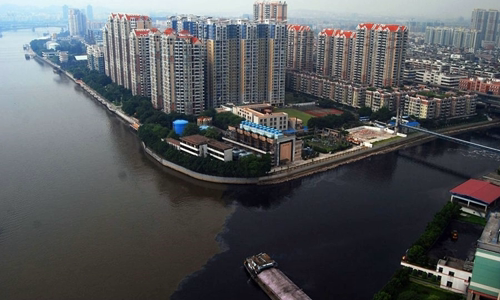The green watercolor of the Riachuelo River, which flows around the southern edge of Buenos Aires, is a reminder of its pollution level.
The river is 64 km long and the surrounding area, called the Matanza-Riachuelo basin in Argentina, is home to over 4 million people. About 15,000 industries discharge waste into the river, contaminating it with arsenic, cadmium, chromium, hydrocarbons, sulfur, zinc and lead.

The tunnel was built to clean Argentina's Riachuelo River Photo: Salini Impregilo
In 2008, the Argentine Supreme Court ruled that it was necessary to treat the flow of pollutants into Riachuelo. The river cleanup plan consists of three buildings.
The first project is called the Stream Left Bank Collector, a network of deep-water tunnels designed to block industrial and domestic waste water and divert it to a treatment plant - the project's second facility. . The plant will separate solid waste from water.
The third is a $ 450 million hydraulic tunnel that acts as an outlet for treated water. It is under construction by a joint venture led by Italian civil engineering company Salini Impregilo. The tunnel is expected to be completed in 2021 and it will be among the longest underwater tunnels in the world, with a length of 12 km.
Mirko Martini, chief engineer of Salini Impregilo, said very few tunnels were dug in conditions like those in the Riachuelo River. "Everything is challenging," he said. "You have to remember that we are under a river with great pressure and we are digging tunnels," he said.
Once completed, the system will transport and treat wastewater at a rate of 27 m3 / sec, improve sanitary conditions along the riverbank and provide a long-term and sustainable solution for safe wastewater treatment. from Buenos Aires.
The Pearl River Delta in Guangdong Province is one of the fastest growing regions in China, averaging over 13% since the early 1980s. However, economic growth is also accompanied by environmental consequences. . Chau Giang, China's third longest river, becomes heavily polluted, many of its tributaries have water quality below the national standard and cannot be used as a source of drinking water.

Chau Giang river water turned black in 2008 Photo: Yangcheng Evening News
Domestic wastewater discharges into the river system which is mostly untreated. In 2005, about 55% of wastewater in Foshan city was treated, while this figure in Jiangmen was 22%.
The amount of wastewater collected and treated by Foshan increased from 55% in 2005 to 88% in 2013, thanks in part to an increase in the capacity of the Chan An wastewater treatment plant from 200,000 to 250,000 m3.
4 new mud treatment facilities with a total capacity of 220 tons / day ensure sludge is handled properly and safely, preventing contamination of groundwater and surrounding waterways. 6.7 km of embankment along the Part Ha river was improved by blocking sewage, diverting it to a wastewater treatment plant and raising the river bank to avoid flooding.
Water quality is improved after nearly 700,000 m3 of sediment is dredged from the river bed. Four automatic water quality monitoring stations and water environment management information systems have been set up, including an emergency response system to encourage the environmental protection agency to quickly handle pollutant discharge cases. infect the river.
In Giang Mon, the amount of wastewater collected and treated increased from 22% in 2005 to 70% in 2013, due to the capacity of the Wen Chang Sha wastewater treatment plant increasing from 50,000 to 200,000 m3 / day. They also built a pumping station and 22 km of sewers, serving about 500,000 people in urban areas.
"Wastewater used to be everywhere in the village, now it is concentrated through sewers. Our living conditions have improved and we are all very happy," said Liang Jingzhou, head of the committee. Ha Bien village, said.

A billboard floating on the Pasig River in the Philippines in 2014 Photo: wheninmanila
In the 1950s, few dared to bathe in the Pasig River, 27 km long from Lake Laguna de Bay, winding through central Manila, then into Manila Bay in the Philippines. By the 1980s, all fishing activities had stopped and the water stinked. By 1990, the river was considered "dead" - no creature existed in the water.
"The domestic sewage has not been treated and industrial wastewater flows into it. Due to the poor collection of waste and the lack of appropriate landfills in the surrounding areas, the river has basically become a dump. rubbish, "says Rudolf Frauendorfer, an expert from the Asian Development Bank.
The Pasig River Restoration Committee (PRRC) was established in 1999, with the aim of rehabilitating the Pasig River to its pristine condition. The effort was boosted in 2010 with the help of the Danish International Development Agency (DANIDA) and the Asian Development Bank, which lent $ 200 million to the Philippine government.
An estimated 65% of the waste flowing into the Pasig River comes from the poor community living in temporary houses on the edge of the river. In order to change, the Manila Metropolitan Area Development Authority stated that they had to live 3-10 meters from the river bank, and the government also resettled those people to the suburbs.
There are some creative ideas for pollution treatment on the Pasig River. In 2014, a Japanese beauty brand set up a 27 m long billboard on the river. It is made from Vetiver grass that absorbs toxic substances, often used to treat sewage. The billboard is said to clean 7,500 to 30,000 liters of water a day. The Japanese firm said the billboard's message was "quickly clean up the river" to change the way people perceive river pollution.
In October 2018, PRRC was awarded the Asia Riverprize for its efforts to renovate the Pasig River. The PRRC declares that aquatic life has returned to the river. Some of the achievements of the PRRC were the resettlement of more than 18,000 families living along the riverbank, dismantling 376 invasive private structures, separating 22,000 kg of solids from waste water, establishing environmental conservation areas and educating people about environmental protection consciousness.
"These efforts have led to significant improvements in water quality, as well as the revival and development of the Pasig river system," the International River Organization issued a statement.



 JessicaSchoenfelder
JessicaSchoenfelder







